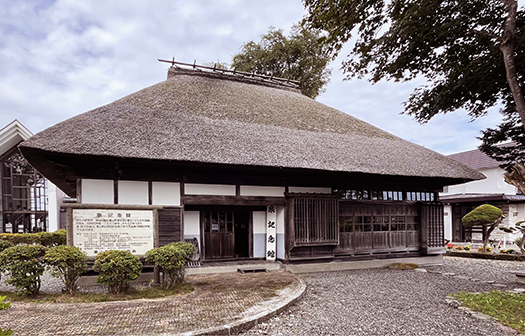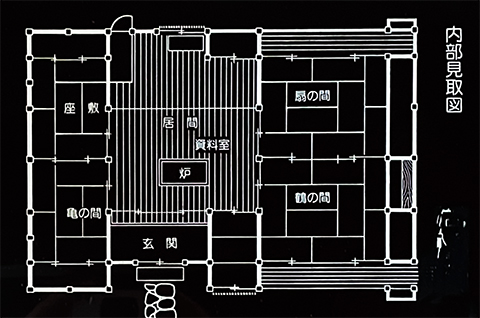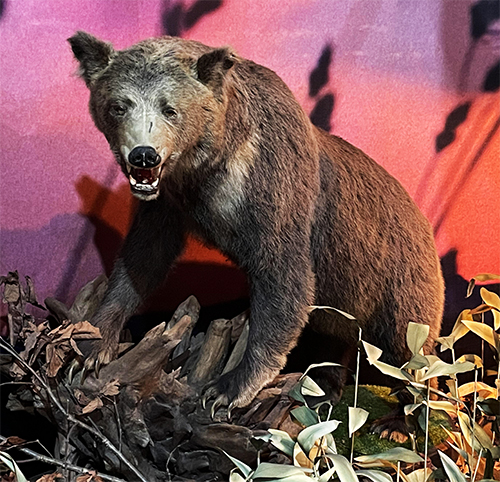


きのうからの続き。明治3年5月、戊辰戦争の敗北側・仙台藩の一領域、現角田市から、その士族群が新天地として北海道への入植に旅立った。当初の入植地は室蘭。集団の規模は44戸51名と記されている。婦女子は当面は故地に残して開拓の労働力としての男性たちが主体で、室蘭の輪西地域の原野の伐採、畑起こしに取り組んだのだろうと思われる。以降18年間に渡って牧場・林業・園芸・炭焼き・養蚕さらには「氷」を作って売ったり、さらには製鉄までも手掛けていたという。すごい開墾努力。
10年経過後の明治14年にはさらに第2陣の開拓民を受け入れて本格的な開拓を進めようとした矢先、明治20年、それらの開拓地に新政府側から「屯田兵」110戸528人が入植し、さらに第2陣として110戸の入植が予定されるに至る。戊辰戦争敗者たちがせっかく開拓した地域を新政府側が「巻き上げる」に等しい。狭隘な輪西地域は共存は困難を極め、やむなく角田からの一統は、新天地をさらに奥地に求めることになった。その無念さは、察するにあまりあるけれど、先人たちはそれも受忍して栗山、当時の「アノロ」原野に向かうことになった。当たり前だけれど、明治初年の権力状況がそのまま反映した背景事情に思いが募る。
このさらなる移住に際しても、冷静に計画を立案し「夕張開墾企業組合」という合資組織を立ち上げたのだという。事に当たってこういった経済的基盤を整備して財政的メドをも付けていた。移動に際しての最終困難であった夕張川渡河の局面では、アイヌ人による輸送舟はたった1人しか乗られず、いわば人身御供のように乗船したのは、万一のことがあってもその後の開墾労作業に影響の少ない女性が渡ったのだという。その状況を追記するとまことに万感が胸に痛みとして迫ってくる。
いま室蘭本線という室蘭から岩見沢までの地方線があるけれど、その路地に沿って移動したことになる。
しかしこの栗山にいまも記念館として残る開拓の主導者・泉麟太郎邸には、いかにもな武家様式が見られるのだと。たしかに間取りには農作業を主とした「土間」がなく、間取り図は南が下の図面だけれど、北側にも縁が設けられている。寒冷対応よりも、格式優先・伝統最優先の「屋敷」建築。

写真は開拓・開墾作業を示したジオラマで目に飛び込んできたヒグマ。平野部であり木の伐採などを行えば、畑地を獲得することは出来ただろうけれど、木材伐採の斧や農地開墾のクワなどでかれらとも立ち向かって、追い払い、人跡を記していったのだろう。ヤワになった現代人であるわたしにはヒグマと聞いただけで震え上がってしまうけれど、淡々と人間社会領域を拡大していく先人には、まことにアタマが下がる。
English version⬇
120 years ago, in the 30s of Meiji era, Kuriyama pioneer leader’s house
The new Meiji government dealt harshly with the defeated samurai families in the management of Hokkaido. However, they responded with careful and calm pioneering plans and carried them out. It is amazing. The home of a pioneer leader in Chestnut Mountain in the Meiji 30’s.
Continued from yesterday. In May of the 3rd year of Meiji, a group of samurai from a region of the Sendai clan, now Kakuda City, on the losing side of the Boshin War, left to settle in Hokkaido as a new land. The initial settlement was in Muroran. The size of the group is described as 44 households with 51 members. It is thought that the women and children were left behind for the time being, and the men were mainly used as pioneer laborers, clearing the wilderness in Muroran’s Rinsei area and cultivating the fields. Over the next 18 years, they were involved in ranching, forestry, horticulture, charcoal making, sericulture, making and selling “ice,” and even iron manufacturing. What an amazing effort to cultivate land!
In 1887, just as they were about to accept the second group of settlers and proceed with full-fledged cultivation, 110 households of 528 “Tondenbei” from the new government settled in those settlements, and another 110 households were scheduled to be settled in the second group. The new government was “taking over” the areas that had been cultivated by the losers of the Boshin War. The narrow Wansei area was extremely difficult to coexist with, and the Kakuda lineage had no choice but to seek a new land further into the country. The regret of the situation is hard to imagine, but the predecessors accepted the situation and headed for Kuriyama, then known as the “Anoro” wilderness. It is only natural, but the background circumstances reflecting the power situation at the beginning of the Meiji period are very interesting.
In this further emigration, they calmly drew up a plan and established a joint-stock organization called the “Yubari Development and Reclamation Enterprise Cooperative Association. They had also established an economic foundation and made financial preparations for the move. The final difficulty in the migration was the crossing of the Yubari River, where only one Ainu person was allowed to board the boat. When I write about this situation, I feel a pain in my heart.
Now there is a local line called Muroran Main Line from Muroran to Iwamizawa, and it was along this route that the woman crossed.
The house of Izumi Rintaro, the pioneer who led the development of Kuriyama, still remains as a memorial museum, and it is decorated in a samurai style. Indeed, there is no “earthen floor,” which was mainly used for farming, and although the floor plan is drawn with the south side down, there is an edge on the north side as well. The “yashiki” architecture prioritizes style and tradition rather than cold weather.
The photo shows a brown bear that caught my eye in a diorama showing pioneering and land reclamation work. Although it would have been possible to acquire farmland by felling trees in the plains, the bears must have confronted them with axes for cutting timber and with staggers for cultivating farmland, drove them away, and left a human trail behind. As a modern, more experienced person, I shudder at the mere mention of the word “brown bear,” but I am truly impressed by our ancestors’ efforts to expand the human social sphere.
Posted on 9月 24th, 2024 by 三木 奎吾
Filed under: 歴史探訪







コメントを投稿
「※誹謗中傷や、悪意のある書き込み、営利目的などのコメントを防ぐために、投稿された全てのコメントは一時的に保留されますのでご了承ください。」
You must be logged in to post a comment.